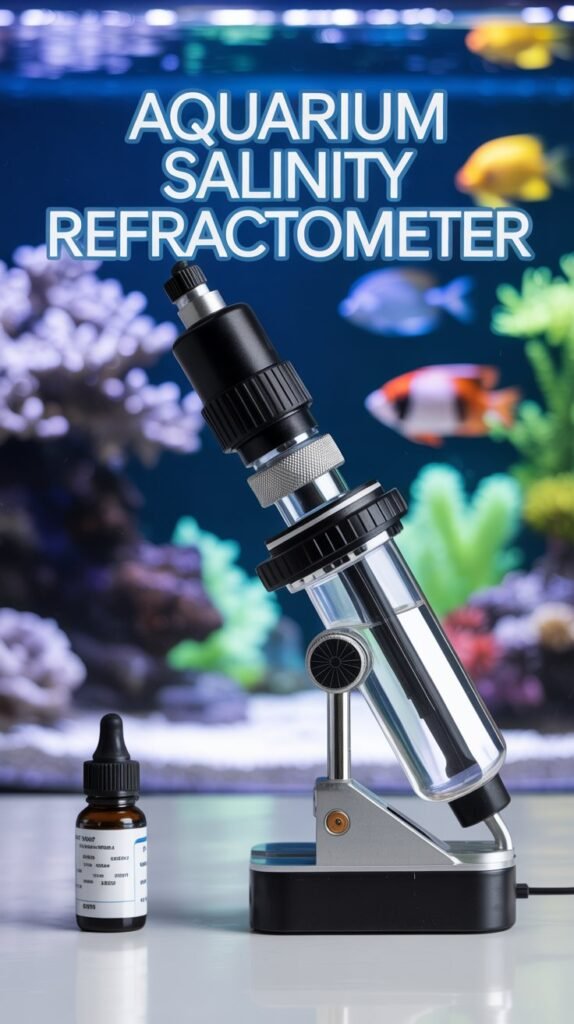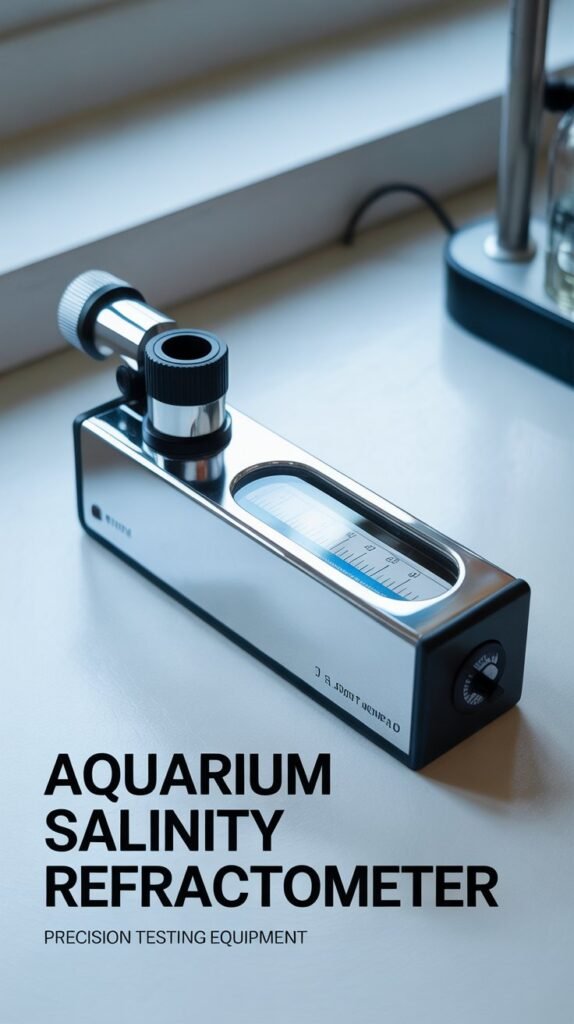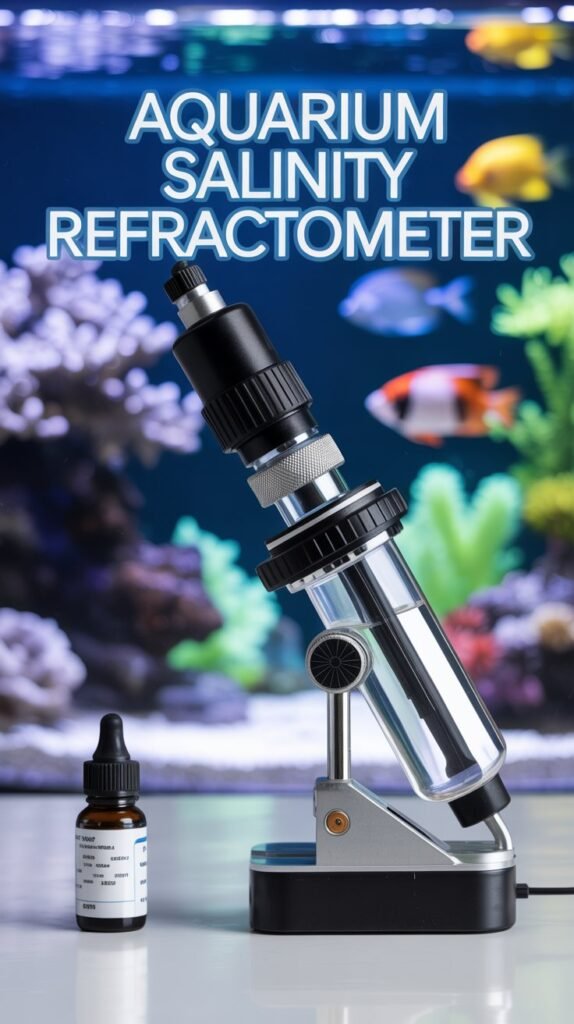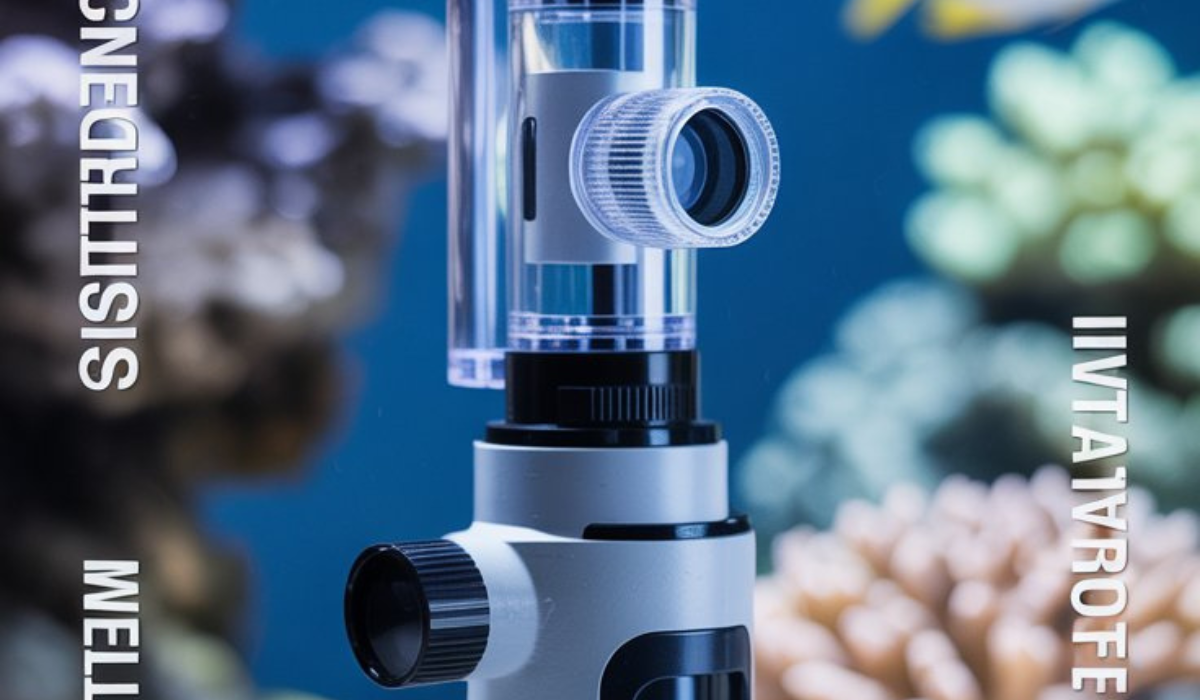Maintaining proper water salinity is one of the most critical aspects of keeping a healthy aquarium, especially for saltwater and reef tanks. Whether you’re a seasoned aquarist or a beginner exploring marine aquariums, the aquarium salinity refractometer is one of the most reliable tools you can own.
This device helps you ensure that your fish, corals, and invertebrates thrive in stable water conditions by accurately measuring the salt concentration in your aquarium water. In this guide, we’ll explore everything about aquarium salinity refractometers — their function, types, calibration, maintenance, and why they are superior to traditional hydrometers.
What Is an Aquarium Salinity Refractometer?
An aquarium salinity refractometer is a precision instrument designed to measure the salinity or specific gravity of water. It works based on the principle of light refraction — the way light bends when it passes through liquids with different densities.
In simple terms, when you place a drop of aquarium water on the refractometer’s prism, light passes through it. The device measures how much that light bends (refracts), which directly correlates to the salt concentration in the water.
This makes refractometers extremely precise tools for monitoring salinity levels in marine aquariums, saltwater fish tanks, and reef systems.
Why Is Salinity Important in Aquariums?

Salinity refers to the amount of dissolved salts (mostly sodium chloride) in water. For marine life, this is a vital environmental factor. Even small fluctuations in salinity can cause stress or health issues in fish and corals.
1. Marine Fish Health
Saltwater fish are adapted to specific salinity ranges. Too much or too little salt can affect their osmoregulation — the process by which they balance water and salts within their bodies.
2. Coral and Invertebrate Survival
Corals, shrimp, snails, and other invertebrates are highly sensitive to salinity changes. Sudden shifts can cause bleaching, stress, or death.
3. Biological Balance
Stable salinity promotes healthy biological filtration, ensuring beneficial bacteria function effectively in your tank.
4. Accurate Water Mixing
When preparing saltwater from marine salt mixes, a refractometer ensures the correct salinity before adding water to the tank — preventing shock to aquatic life.
The ideal salinity for most marine aquariums is 1.023 to 1.026 specific gravity, or about 35 parts per thousand (ppt). Regular monitoring helps maintain this stable range.
How Does a Refractometer Work?
A refractometer works on the principle of refractive index measurement. When light travels through a liquid, it bends depending on the liquid’s density. Saltwater has a higher density than freshwater, so it bends light differently.
Here’s how it works step-by-step:
- Place a few drops of your aquarium water on the refractometer’s prism.
- Close the cover plate to spread the water evenly and avoid air bubbles.
- Look through the eyepiece (in manual models) or read the display (in digital models).
- The device shows the salinity or specific gravity of your aquarium water.
This reading allows you to adjust your aquarium water as needed — adding freshwater to reduce salinity or adding saltwater to increase it.
Types of Aquarium Salinity Refractometers
There are two main types of aquarium refractometers available for aquarists:
1. Manual Optical Refractometer
This is the traditional type of refractometer. It has an eyepiece through which you manually read the measurement. It’s affordable, reliable, and doesn’t require batteries.
Advantages:
- Cost-effective
- Durable and long-lasting
- Simple to use once calibrated
Disadvantages:
- Requires manual reading
- Can be affected by lighting conditions
- Needs periodic calibration
2. Digital Salinity Refractometer
A digital refractometer uses a sensor and LCD display to show results automatically. It eliminates human error from reading scales manually.
Advantages:
- Easy-to-read digital display
- Fast and accurate results
- Temperature compensation feature
Disadvantages:
- More expensive
- Requires batteries or power
- May need regular maintenance
Both types can work excellently for aquarium purposes, but digital refractometers are becoming increasingly popular due to their precision and convenience.
Refractometer vs. Hydrometer: Which Is Better?

Before refractometers became popular, aquarists often used hydrometers to measure salinity. However, refractometers are now considered far superior. Let’s compare both:
| Feature | Refractometer | Hydrometer |
|---|---|---|
| Accuracy | Very high (±0.001 SG) | Moderate |
| Ease of Use | Quick and simple | Requires more steps |
| Durability | Long-lasting | Fragile |
| Calibration | Occasionally needed | None, but prone to errors |
| Cost | Higher upfront | Lower cost |
In summary, hydrometers are budget-friendly but less reliable. A refractometer is an investment in accuracy and long-term stability, especially for reef or marine setups where precision is vital.
How to Use an Aquarium Salinity Refractometer
Using a refractometer is straightforward once you get the hang of it. Here’s a simple guide:
Step 1: Calibrate the Refractometer
Before using it for the first time (and periodically afterward), calibrate your refractometer. Use distilled or RO (reverse osmosis) water.
- Place 2–3 drops of distilled water on the prism.
- Wait for 30 seconds.
- Adjust the calibration screw until the reading shows 0 ppt or 1.000 SG.
Step 2: Add Your Sample
Place a few drops of your aquarium water on the prism. Make sure there are no air bubbles.
Step 3: Read the Measurement
- For optical models: Look through the eyepiece and read the boundary line on the scale.
- For digital models: The reading appears on the screen instantly.
Step 4: Record and Adjust
If salinity is too high, add freshwater.
If it’s too low, add more saltwater.
Always make adjustments gradually to avoid stressing your fish.
Automatic Temperature Compensation (ATC)
Most modern refractometers come with ATC (Automatic Temperature Compensation). This feature corrects readings automatically based on ambient temperature changes. Since temperature affects water density, ATC ensures accurate readings without manual adjustments.
When shopping, always check that the model includes ATC — especially if your aquarium room experiences temperature variations.
How to Calibrate an Aquarium Salinity Refractometer

Calibration ensures your readings are always precise. Even the best refractometer can drift over time due to temperature, usage, or minor wear.
You’ll Need:
- Distilled or RO water (for zero calibration)
- Standard calibration solution (usually 35 ppt)
Calibration Steps:
- Clean the prism using a lint-free cloth.
- Add a few drops of calibration fluid or distilled water.
- Close the cover and wait a few seconds.
- Adjust the calibration screw until the scale reads 35 ppt (if using standard solution) or 0 ppt (if using pure water).
- Rinse and dry before measuring aquarium water.
Recalibrate every 2–4 weeks or when temperature or environmental conditions change significantly.
Cleaning and Maintenance Tips
Proper care ensures accurate readings and extends the life of your refractometer.
- Rinse after each use with distilled water.
- Wipe dry gently with a soft cloth; avoid scratches.
- Store in a dry case to protect the optics.
- Avoid salt buildup on the prism.
- Do not submerge the refractometer in water.
Regular maintenance keeps your refractometer reliable and your tank’s salinity stable.
Choosing the Best Aquarium Salinity Refractometer
When buying a refractometer, consider the following factors:
1. Accuracy
Look for models with ±0.001 SG or better accuracy. This precision is crucial for reef aquariums.
2. Measurement Range
Most aquarium refractometers measure 0–100 ppt salinity and 1.000–1.070 SG. Ensure your device covers the typical marine range.
3. ATC Feature
Automatic Temperature Compensation simplifies readings under varying temperatures.
4. Build Quality
Choose a metal-bodied or rubber-coated design for durability and grip.
5. Calibration Method
A model with an easy calibration screw or digital auto-calibration is preferable.
6. Brand and Reviews
Popular brands like Vee Gee, Milwaukee, Hanna Instruments, and AquaLutio are known for reliability and precision.
Benefits of Using a Salinity Refractometer
- High Accuracy: Detects even minor fluctuations.
- Quick Results: Provides instant readings.
- Cost-Effective Long Term: No need for replacements like hydrometers.
- Durability: Built to last for years with minimal maintenance.
- Temperature Compensation: Ensures accuracy in all conditions.
- Professional-Grade Precision: Used by marine biologists and aquarium professionals.
Common Mistakes to Avoid
- Skipping Calibration: Leads to inaccurate readings.
- Using Dirty Prism: Salt residue interferes with light refraction.
- Ignoring Temperature Effects: Always use ATC or compensate manually.
- Taking Samples from Surface Only: Mix water before testing for uniform results.
- Rough Handling: Dropping or scratching the prism can ruin accuracy.
Avoiding these mistakes ensures your refractometer remains a trusted tool for years.
Troubleshooting Inaccurate Readings
If your refractometer gives inconsistent results:
- Recalibrate with proper fluid.
- Clean the prism thoroughly.
- Check for scratches or damage.
- Allow temperature stabilization before testing.
- Avoid air bubbles under the cover plate.
If issues persist, consider professional recalibration or replacing the unit.
How Often Should You Check Salinity?
For best results, test salinity 2–3 times a week — especially in smaller tanks where evaporation can quickly alter salt levels. Always test:
- After water changes
- When topping off evaporation losses
- After adding new saltwater or equipment
Keeping salinity stable ensures the well-being of your fish and corals.
Top Tips for Maintaining Stable Aquarium Salinity
- Use an auto top-off system (ATO) with freshwater to offset evaporation.
- Mix saltwater completely before adding it to the tank.
- Monitor temperature, as heat increases evaporation.
- Use a high-quality marine salt mix for consistency.
- Record readings in a logbook to track trends.
Consistency is key — a good refractometer helps achieve that.
Conclusion
An aquarium salinity refractometer is an indispensable tool for any marine aquarist. It delivers unmatched precision, ensuring your fish, corals, and invertebrates live in perfectly balanced conditions. Unlike hydrometers, it offers long-term reliability, easy use, and accurate readings every time.
By regularly checking and maintaining your tank’s salinity using a calibrated refractometer, you can prevent stress, disease, and instability in your aquarium ecosystem. Whether you choose a manual or digital model, investing in a high-quality refractometer guarantees healthier marine life and peace of mind.
FAQs About Aquarium Salinity Refractometers
Q1: How often should I calibrate my refractometer?
A: Calibrate it at least once a month, or every two weeks if you use it frequently.
Q2: Can I use tap water for calibration?
A: No. Always use distilled or RO water for accurate zero calibration.
Q3: What is the ideal salinity for reef tanks?
A: The recommended salinity range is 1.023–1.026 specific gravity or 35 ppt.
Q4: Is a digital refractometer better than an optical one?
A: Digital models are easier to read and more precise, but optical ones are durable and affordable.
Q5: Do I need to consider temperature while using a refractometer?
A: Yes, but most modern refractometers come with Automatic Temperature Compensation (ATC).
Q6: Can I use the same refractometer for freshwater and saltwater?
A: Technically yes, but it’s best to use separate devices for different water types to maintain accuracy.
Q7: Why are my readings inconsistent?
A: This could be due to improper calibration, dirty prism, or temperature fluctuations.
Q8: What’s better for beginners — refractometer or hydrometer?
A: A refractometer is recommended for both beginners and professionals because of its superior accuracy.

